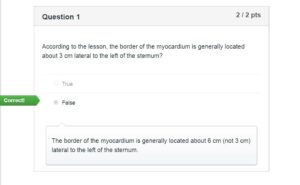Instructions
The late assignment policy does not apply to quizzes and exams. All quizzes and exams close at the time they are due. For quizzes and exams not submitted by the specified due date and time, a score of zero will be assigned.
The Week 4 quiz has 5 questions (multiple choice). You will have one attempt.
Question 1
2 / 2 pts
According to the lesson, the border of the myocardium is generally located about 3 cm lateral to the left of the sternum?
True
False
The border of the myocardium is generally located about 6 cm (not 3 cm) lateral to the left of the sternum.
Question 2
2 / 2 pts
According to the Bates’ Visual Guide video 10.9 Auscultation of Heart Sounds, splitting of S2 is best heard during inspiration over which area on the chest wall?
Apex
Pulmonic
Mitral
Aortic
A split S2 is best heard at the pulmonic valve listening post, as P2 is much softer than A2. Like the S1 heart sound, the S2 sound is described regarding splitting and intensity.
Question 3
2 / 2 pts
According to the lesson, low-pitched sounds of S3 and S4 and the murmur of mitral stenosis are best heard using what?
The bell and diaphragm are equally effective for this task
The bell of the stethoscope
The naked ear
The diaphragm of the stethoscope
Listen throughout the precordium with the diaphragm, pressing it firmly against the chest. The bell is more sensitive to the low-pitched sounds of S3 and S4 and the murmur of mitral stenosis. Apply the bell lightly, with just enough pressure to produce an air seal with its full rim. Use the bell at the apex, then move medially along the lower sternal border. Resting the heel of your hand on the chest like a fulcrum may help you to maintain light pressure.
Question 4
1.33 / 2 pts
According to the lesson, heart failure can be assessed using the Framingham criteria. Which of the following findings are major criteria suggestive of heart failure? (Select all that apply)
You Answered
Ankle edema
Neck-vein distention
S3 gallop
Orthopnea
For establishing a diagnosis of CHF using the modified Framingham Criteria, 2 major criteria or 1 major and 2 minor criteria must be present. Major criteria are: Paroxysmal nocturnal dyspnea or orthopnea ; Neck-vein distention; Rales; Cardiomegaly; Acute pulmonary edema; S3 gallop; Increased venous pressure >16 cm of water; and Hepatojugular reflux.
Question 5
2 / 2 pts
According to the lesson, the JVP is best assessed from pulsations in the right internal jugular vein, which is directly in line with the superior vena cava and right atrium?
True
False
Estimating the JVP is one of the most important and frequently used skills of physical examination. The JVP closely parallels pressure in the right atrium, or central venous pressure, related primarily to volume in the venous system. The JVP is best assessed from pulsations in the right internal jugular vein, which is directly in line with the superior vena cava and right atrium.
Solution:

Click the Icon below to purchase the full solution @10